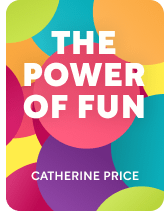

This article is an excerpt from the Shortform book guide to "The Power of Fun" by Catherine Price. Shortform has the world's best summaries and analyses of books you should be reading.
Like this article? Sign up for a free trial here.
How much time do you waste every day? What if you used that time to have more fun in life?
In The Power of Fun, award-winning science writer Catherine Price argues that fun is fundamental to a happy and healthy life. She explains two ways that modern society has made it harder to prioritize fun. Then, she discusses how to make time for fun.
Continue reading to get a handle on why making time for fun can be so difficult and to discover the first step you can take to turn that around.
Why Are We Having Less Fun?
Before we look at Price’s advice on how to make time for fun, let’s go over what gets in our way. She argues that, despite research that seems to demonstrate the positive impact fun has on our lives, people today spend less time having fun than they did in previous generations. She explains that our changing relationships to time and technology inhibit our opportunities for play, connection, and flow that are necessary to experience True Fun.
(Shortform note: It’s difficult to measure and compare the subjective experience of fun across generations. However, numerous studies have shown that Gen Z adults and millennials report higher levels of stress than was experienced in their parents’ and grandparents’ generations. While this doesn’t directly support Price’s claim that people today have less fun than older generations, it does reveal generational differences in self-reported well-being that may in part be affected by how people spend their leisure time.)
Our Changing Relationship to Time
Citing the work of Celeste Headlee, author of Do Nothing, Price explains how the rise of industrialization meant workers began being paid by the hour instead of for completed tasks, establishing an incentive to work as many hours as possible to make as much money as possible. Suddenly, time was equivalent to money, leading to the assumption that time not spent making money (including time spent having fun) is time wasted.
(Shortform note: Headlee suggests that our changing relationships to time, which she describes as “hustle culture,” is largely to blame for increasing rates of burnout that were exacerbated during the Covid-19 pandemic. In a survey conducted by Indeed in 2021, over half (52%) of survey respondents experienced burnout in 2021, up from the 43% who said the same in Indeed’s pre-Covid-19 survey.)
The changing attitude toward time was coupled with the rise of consumer culture. The Industrial Revolution resulted in an increase in the mass production of goods, which companies then needed to sell to make a profit. To sell the oversupply of goods, companies needed to create demand, which they did by building marketing campaigns that convinced people that owning more stuff would make their lives better.
(Shortform note: While the mass production of goods and the drive to increase profits contributed to a growing consumer culture, it was not the sole cause. Before the Industrial Revolution, there was a big divide between the rich and the poor, but the growth of new businesses and factories during the Industrial Revolution created thousands of new jobs, allowing the middle class to grow. This middle class had more money to buy nicer homes and education, and they also had disposable income to buy things they didn’t necessarily need. The introduction of more sophisticated marketing tactics in the 1950s and the outsourcing of labor and manufacturing to countries with lower wages further contributed to the growth of consumption.)
The result was that people spent more time working in order to be able to buy more things that were marketed as a means to improve life, leaving them less time to pursue opportunities for playfulness, connection, and flow.
(Shortform note: While the Industrial Revolution changed how we think about time and work, it increased rather than decreased leisure time for the average person. Employers reduced working hours and introduced half-day Saturdays, giving workers more free time. Vacations, though usually unpaid, also became more common. The desire for leisure was fueled by the monotony of industrial work and urban crowding. Additionally, the installation of electric lighting also made nighttime leisure activities safer. As a result, people increasingly attended various leisure activities both within and outside cities, and new forms of entertainment emerged and spread across the country.)
Our Changing Relationship to Technology
Our increasing dependence on technology, and specifically smartphones, has further weakened the role of fun in our lives, primarily by replacing True Fun with lesser forms of fun, like distraction and passive entertainment. Price argues that smartphones are the number one source of this kind of bogus fun because they’re designed to be addictive, relying on novelty, rewards, and a lack of predictability to hold our attention. While Price acknowledges that our phones can provide a temporary escape from stress or boredom, she argues that they ultimately fail to contribute to our overall happiness and well-being.
(Shortform note: Studies suggest that people diagnosed with ADHD are especially susceptible to the negative impact of smartphone use. For example, one study of South Korean adolescents found ADHD to be a significant risk factor for developing smartphone addiction. This addiction is associated with other mental disorders as well: The same study found that adolescents identified as having a smartphone addiction were more likely to display symptoms of depression and anxiety.)
According to Price, the ubiquity of smartphones also limits our capacity for playfulness, connection, and flow. Phones contribute to our sense of busyness and stress, which makes it difficult to relax and engage in spontaneous, unstructured play. Our overreliance on technology for entertainment has also limited our ability to be imaginative and creative. In addition, phones, despite the illusion of connectedness they provide, isolate us by making us less likely to initiate conversations with strangers or put effort into quality in-person interactions. Worst of all, phones are a constant source of distraction, which prevents us from ever entering a flow state.
(Shortform note: The impact of smartphones on our lives is particularly stark for the generation known as iGen, people born between 1995 and 2012. This generation has always had access to the internet and was likely on social media before they were in middle school. Psychologists who study generational differences have noted that while this generation is safer than previous ones in some ways (for example, less likely to get in a car accident or have unprotected sex), they have unprecedented rates of teen depression and suicide.)
How to Make Time for Fun
Price explains that you don’t just start having more fun because you’ve decided to; you also need to create the conditions that are conducive to fun. To attract more fun into your life, Price says that you first need to make time for fun.
If you’re going to prioritize fun, you need to make space for it to happen. The first step in making time is to give yourself permission to have fun. Many of us have been socialized to think of fun as self-indulgent or unproductive; we are convinced that our time would be better spent in more serious (often work-related) pursuits. But Price reiterates that fun isn’t at odds with being a hard worker or making the world a better place. In fact, she adds, fun might actually support you to do these things better by helping you feel more energized, inspired, and creative.
(Shortform note: Price’s argument for the value of fun is supported by a 2020 study that found the key to a happy and fulfilling life is a balance of “hedonistic pursuits” and a healthy work ethic. While self-control is crucial for aligning with long-term goals, the study emphasizes the need to pay equal attention to hedonism, or the ability to experience pleasure without guilt or shame. However, for many people, the guilt that comes with self-indulgence prevents them from reaping the benefits of these experiences.)
After you give yourself permission to have fun, think about how you can free up time in your day for fun. This might mean focusing on your high-impact tasks at work, saying no to obligations that aren’t necessary or fun, and setting boundaries with your phone and other devices. When you don’t fill your day with busy work, unnecessary obligations, or screens, you might be surprised at how much time you get back.
(Shortform note: In 168 Hours, Laura Vanderkam argues that there’s enough time every week for you to work, spend time with family and friends, and have fun. The trick is to manage your time intentionally. To begin better managing your time (and free up time for fun), Vanderkam recommends documenting how you spend your time each week and then reviewing your time record to better understand if you’re using your time in ways that align with your priorities.)
You might need some help making time for fun. If you’re a parent or in a relationship, ask your family for support. Have a conversation with your partner about how you’re sharing the burden of the mental and emotional labor of your household. Then carve out space for each of you to have independent fun every week. This will create a virtuous cycle of goodwill that you’ll both continue to benefit from.
(Shortform note: If you want to talk about fun with your partner, invite them on a date. The authors of Eight Dates write that it’s crucial to talk about fun and playfulness with your partner because having fun with your partner builds trust and intimacy and strengthens your relationship. The authors recommend talking about past fun experiences you’ve had (alone or with your partner), your bucket list, and ideas of how to have more fun as a couple.)

———End of Preview———
Like what you just read? Read the rest of the world's best book summary and analysis of Catherine Price's "The Power of Fun" at Shortform.
Here's what you'll find in our full The Power of Fun summary:
- Why fun is fundamental to living a happy and healthy life
- How modern society has made it harder to prioritize fun
- A step-by-step guide to invite more fun into your life






